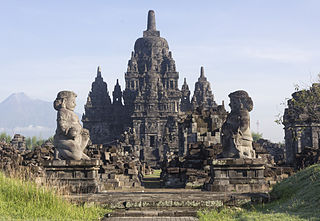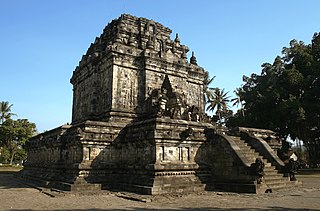
Borobudur, also transcribed Barabudur is a 9th-century Mahayana Buddhist temple in Magelang Regency, not far from the city of Magelang and the town of Muntilan, in Central Java, Indonesia. It is the world's largest Buddhist temple. The temple consists of nine stacked platforms, six square and three circular, topped by a central dome. It is decorated with 2,672 relief panels and originally 504 Buddha statues. The central dome is surrounded by 72 Buddha statues, each seated inside a perforated stupa.

Prambanan is a 9th-century Hindu temple compound in the Special Region of Yogyakarta, in southern Java, Indonesia, dedicated to the Trimūrti, the expression of God as the Creator (Brahma), the Preserver (Vishnu) and the Destroyer (Shiva). The temple compound is located approximately 17 kilometres (11 mi) northeast of the city of Yogyakarta on the boundary between Central Java and Yogyakarta provinces.

A Buddhist temple or Buddhist monastery is the place of worship for Buddhists, the followers of Buddhism. They include the structures called vihara, chaitya, stupa, wat and pagoda in different regions and languages. Temples in Buddhism represent the pure land or pure environment of a Buddha. Traditional Buddhist temples are designed to inspire inner and outer peace.

The Mataram Kingdom ; also known as Medang Kingdom was a Javanese Hindu–Buddhist kingdom that flourished between the 8th and 11th centuries. It was based in Central Java, and later in East Java. Established by King Sanjaya, the kingdom was ruled by the Shailendra dynasty and Ishana dynasty.

Kalasan, also known as Candi Kalibening, is an 8th-century Buddhist temple in Java, Indonesia. It is located 13 kilometers (8.1 mi) east of Yogyakarta on the way to Prambanan temple, on the south side of the main road Jalan Solo between Yogyakarta and Surakarta. Administratively, it is located in the Kalasan District (kapanewon) of Sleman Regency.

Buddhism has a long history in Indonesia, and is recognized as one of the six recognized religions in Indonesia, along with Islam, Christianity, Hinduism and Confucianism. According to the 2018 national census roughly 0.8% of the total citizens of Indonesia were Buddhists, and numbered around 2 million. Most Buddhists are concentrated in Jakarta, Riau, Riau Islands, Bangka Belitung, North Sumatra, and West Kalimantan. These totals, however, are probably inflated, as practitioners of Taoism and Chinese folk religion, which are not considered official religions of Indonesia, likely declared themselves as Buddhists on the most recent census. Today, the majority of Buddhists in Indonesia are Chinese, however small communities of native Buddhists also exist.

A candi is a Hindu or Buddhist temple in Indonesia, mostly built during the Zaman Hindu-Buddha or "Hindu-Buddhist period" between circa the 4th and 15th centuries.

Kedu Plain, also known as Progo River valley, is the fertile volcanic plain that lies between the volcanoes Mount Sumbing and Mount Sundoro to the west, and Mount Merbabu and Mount Merapi to the east. It roughly corresponds to present-day Magelang and Temanggung Regency of Central Java, Indonesia.

Mendut is a ninth-century Buddhist temple, located in Mendut village, Mungkid sub-district, Magelang Regency, Central Java, Indonesia. The temple is located about three kilometres east from Borobudur. Mendut, Borobudur and Pawon, all of which are Buddhist temples, are located in one straight line. There is a mutual religious relationship between the three temples, although the exact ritual process is unknown.

Candi Plaosan, also known as the 'Plaosan Complex', is one of the Buddhist temples located in Bugisan village, Prambanan district, Klaten Regency, Central Java, Indonesia, about 1 kilometre to the northeast of the renowned Hindu Prambanan Temple.
Indonesian Esoteric Buddhism or Esoteric Buddhism in Maritime Southeast Asia refers to the traditions of Esoteric Buddhism found in Maritime Southeast Asia which emerged in the 7th century along the maritime trade routes and port cities of the Indonesian islands of Java and Sumatra as well as in Malaysia. These esoteric forms were spread by pilgrims and Tantric masters who received royal patronage from royal dynasties like the Sailendras and the Srivijaya. This tradition was also linked by the maritime trade routes with Indian Vajrayana, Tantric Buddhism in Sinhala, Cham and Khmer lands and in China and Japan, to the extent that it is hard to separate them completely and it is better to speak of a complex of "Esoteric Buddhism of Mediaeval Maritime Asia." Many key Indian port cities saw the growth of Esoteric Buddhism, a tradition which coexisted alongside Shaivism.

Sewu is an eighth century Mahayana Buddhist temple located 800 metres north of Prambanan in Central Java, Indonesia. The word for a Hindu or Buddhist temple in Indonesian is "candi," hence the common name is "Candi Sewu." Candi Sewu is the second largest Buddhist temple complex in Indonesia; Borobudur is the largest. Sewu predates nearby "Loro Jonggrang" temple at Prambanan. Although the complex consists of 249 temples, this Javanese name translates to 'a thousand temples,' which originated from popular local folklore. Archaeologists believe the original name for the temple compound to be Manjusrigrha.

Prambanan Temple Compounds is the World Heritage designation of a group of Hindu temple compounds that lie on the border between Yogyakarta and Central Java, Indonesia. It comprises Prambanan, Lumbung, Bubrah and Sewu temple compounds, all are located within Prambanan Archaeological Park.

Borobudur Temple Compounds is the World Heritage designation of the area of three Buddhist temples in Central Java, Indonesia. It comprises Borobudur, Mendut, and Pawon. The temples were built during the Shailendra dynasty around the 8th and 9th centuries CE, and fall on a straight line.

Hundreds of ancient stone religious monuments lie on the island of Java. Known as candi in Indonesian, they date from the early classical period of Javanese civilisation, beginning in the first part of the 8th century CE and ending after 900 CE. The majority were built between 780 CE and 860 CE, even though the civilisation that created them existed for many centuries.

Banyunibo is a 9th-century Buddhist temple located in Cepit hamlet, Bokoharjo village, Prambanan, Sleman Regency, Special Region of Yogyakarta, Indonesia. The temple, dating from the era of Mataram Kingdom, sits in a narrow valley surrounded by paddy fields about two kilometers southeast of the Ratu Boko archaeological park on the east side of modern Yogyakarta. Further north is the Prambanan temple, and to the south are the Gunung Sewu hills, extension of Gunung Kidul hills.

Sojiwan is a 9th-century Mahayana Buddhist temple located in Kebon Dalem Kidul village, Prambanan, Klaten Regency, Central Java. The temple is located nearly two kilometres southeast of Prambanan temple. This temple is among numbers of temples scattered in Prambanan Plain.
Karangtengah inscription is the inscriptions written on five pieces of stones dated 746 Saka or 824 CE, discovered in Karangtengah hamlet, Temanggung Regency, Central Java, Indonesia. The inscription was written in ancient Javanese script in two languages; Old Javanese and Sanskrit. The lines 1-24 was written in Sanskrit, the rest of the lines was written in old Javanese. The inscription is linked with the temple Borobudur and Mendut

Jabung is a 14th-century Buddhist temple dated from Majapahit era, located in the Jabung Sisir village (desa), Paiton area, Probolinggo district, East Java, Indonesia. The temple is made from red brick measuring 16.20 metres. The temple was mentioned in Nagarakretagama as Bajrajinaparamitapura, being visited by king Hayam Wuruk during his royal tour across East Java in 1359 CE. The temple is mentioned in Pararaton as Sajabung, a mortuary temple of Bhre Gundal, a member of Majapahit royalties.

Ngawen is an 8th-century Buddhist temple compound in Magelang Regency, Central Java, Indonesia. Located in Ngawen village, Muntilan sub-district, 6 km (3.7 mi) to the east of Mendut temple or 5 km (3.1 mi) to the south of Muntilan town center. Ngawen temple compound consists of five temples, however today only one is successfully reconstructed.






















